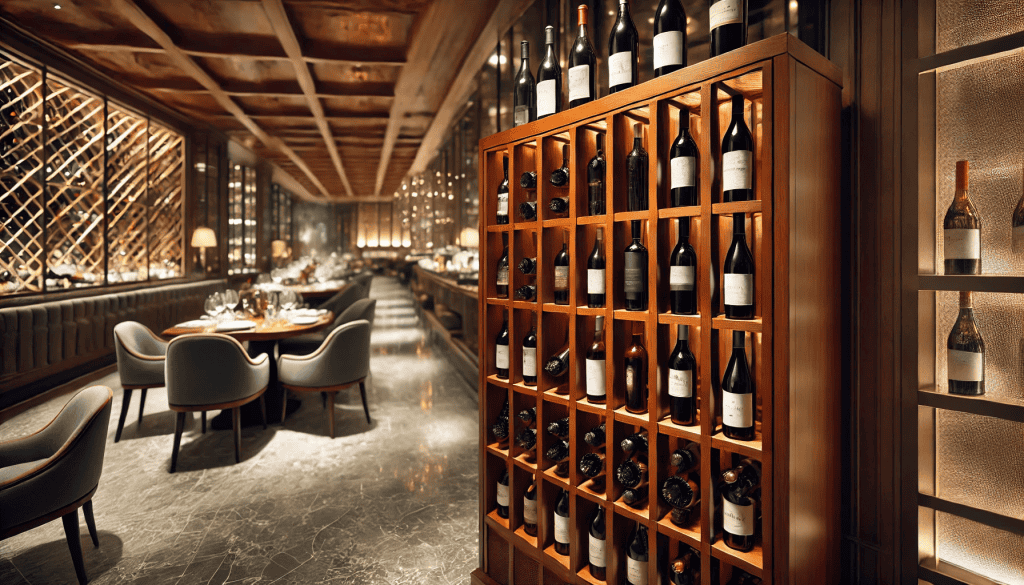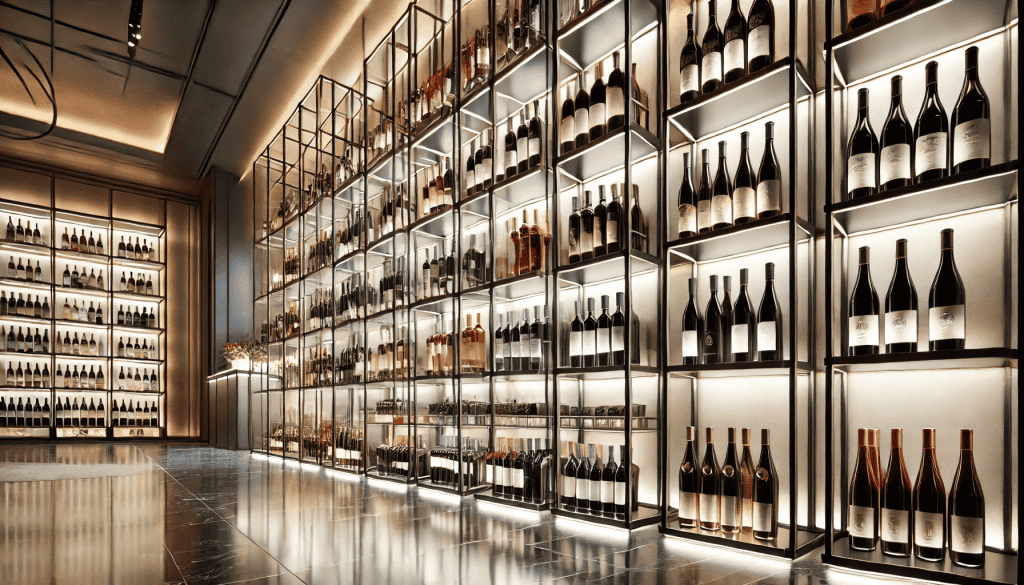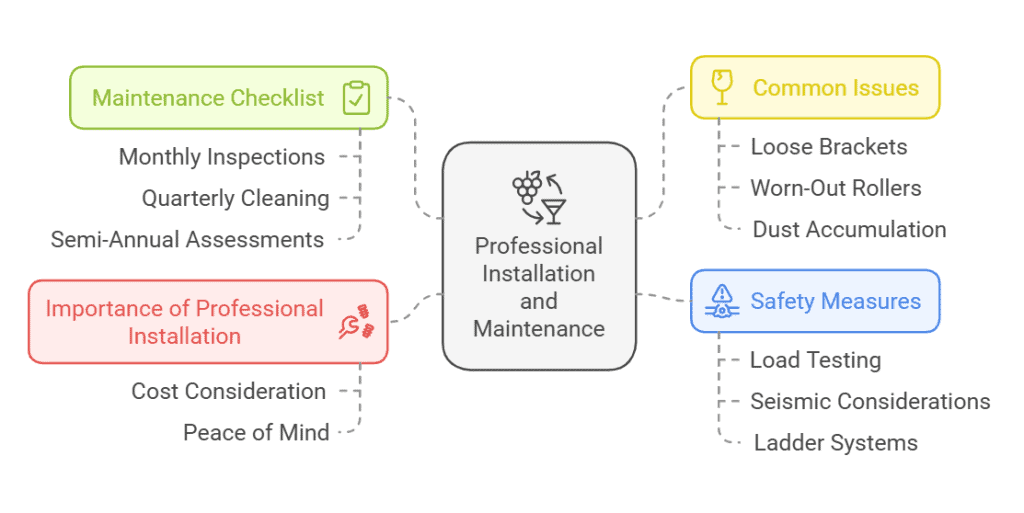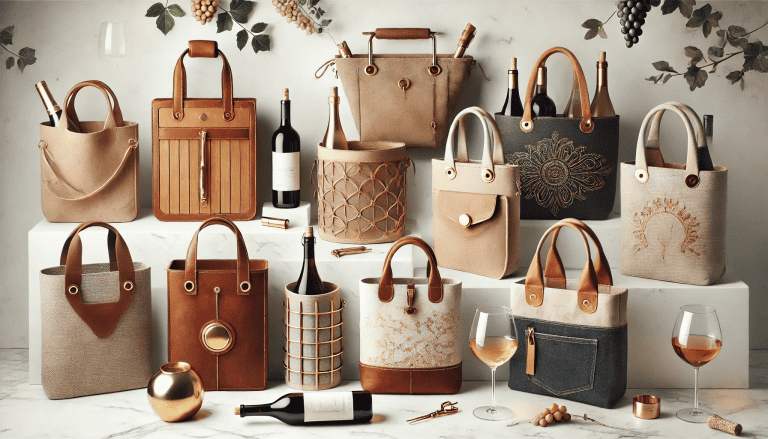Did you know that proper wine storage can increase wine sales by up to 25%?
In the competitive world of wine retail and hospitality, choosing the right commercial wine racking systems isn’t just about storage – it’s about creating impressive displays that drive sales while preserving your valuable inventory.
Whether you’re opening a new wine store, upgrading your restaurant’s wine cellar, or expanding your existing collection, choosing the right racking system is crucial for your business’s success.
Let’s explore how to make this important decision with confidence!
Welcome to Didi Somm, and Cheers!
Important Notice: The information in this article is for general and public information purposes only. It solely reflects Didi Somm’s or his Staff’s opinion, and no responsibility can be assumed for errors or omissions in the service’s contents. For details, please check the Disclaimer at the bottom of the homepage.

Key Takeaways
- Proper material selection ensures longevity and maintains wine quality
- Custom solutions offer better space utilization than standard options
- Climate control integration is essential for commercial wine storage
- Professional installation can prevent costly future problems
- ROI consideration should include both immediate and long-term benefits
Understanding Commercial Wine Racking Materials
After twenty years in the wine storage business, I’ve learned that choosing the right materials for commercial wine racking is like picking the perfect wine – it requires careful consideration of multiple factors.
Let me tell you about the time I helped a client who initially insisted on pine racks for their upscale wine bar. While pine seemed budget-friendly, I showed them how redwood and mahogany offer superior resistance to humidity and aging.
Today, redwood remains my top recommendation for its natural resistance to moisture and rot, plus its stunning aesthetic appeal that only improves with age. Metal racking has come a long way, too – I’ve seen some gorgeous stainless steel installations that perfectly complement modern spaces while offering incredible durability.
The latest trend I’m excited about is the integration of glass and acrylic components, which can transform a simple storage system into an eye-catching display. For commercial environments, durability is non-negotiable – you need materials that can withstand constant handling and varying environmental conditions.
Cost-wise, while premium materials like mahogany might seem steep initially (ranging from $20-35 per bottle space), they often prove more economical in the long run compared to cheaper alternatives that might need replacement after just a few years.

Pro Tip: For more information about wine racking materials, designs, etc., I recommend you to check the website of Wine Racks America
Types of Commercial Wine Racking Systems
Boy, do I love talking about the different types of commercial wine racking systems! Through countless installations, I’ve discovered that the key to success lies in mixing and matching various storage solutions.
Single-bottle Storage & Bulk Storage
Single-bottle storage is your bread and butter – it’s perfect for restaurants where you need quick access to individual bottles. I remember installing a custom system for a high-end steakhouse where we combined single-bottle storage with bulk storage areas for their popular wines. The bulk storage section could hold up to 500 bottles of their house wines, while the single-bottle racks showcased their premium selections.
Case Storage & Display-focused Racking
Case storage is another game-changer, especially for businesses that receive frequent deliveries. Display-focused racking has become increasingly popular – I recently designed a system with LED-lit display rows that increased wine sales by 40% in the first month!
Mixed-use Configurations
The real magic happens when you create mixed-use configurations. I love combining vertical displays with horizontal bulk storage, maybe throwing in some diamond bins for visual interest. This approach gives you the best of all worlds – efficient storage, attractive displays, and easy access.
Space Planning and Capacity Considerations
Listen up because this is where many businesses get it wrong! I learned this lesson the hard way when I designed a system that looked perfect on paper but didn’t account for peak season storage needs.
Bottle Capacity Calculation Formula
Now, I always start by calculating bottle capacity using a simple formula:
Bottle Capacity = Current Inventory + 30% for Growth + 20% for Seasonal Fluctuations
Using Vertical Space
You’d be amazed at how often I see vertical space being underutilized. In one recent project, we doubled storage capacity by extending the racking to the ceiling and incorporating a rolling ladder system.
Aisle Space for Commercial Storage
Traffic flow is crucial – you need at least 36 inches of aisle space in commercial settings, but I prefer 42-48 inches for comfortable browsing.
Pro Tip – Plan for Future Growth
Always plan for future growth. I recommend designing your system in modules that can be expanded later.
Storage Density vs. Display Appeal
The trickiest part is balancing storage density with display appeal. Through trial and error, I’ve found that dedicating about 30% of your visible space to display while maximizing storage density in less visible areas gives the best results.
Climate Control Integration
Let me tell you something that keeps me up at night – seeing beautiful wine collections ruined by poor climate control. Temperature regulation isn’t just about keeping things cool; it’s about maintaining consistency. I learned this lesson when a client lost $50,000 worth of wine due to temperature fluctuations.
Steady Temperature & Humidity
Now, I insist on systems that maintain a steady 55-57°F with no more than 2-degree fluctuations. Humidity management is equally critical – aim for 60-70% humidity to prevent cork shrinkage and wine oxidation.
Active Cooling Systems
When it comes to ventilation compatibility, I always recommend active cooling systems with multiple evaporators for spaces larger than 500 square feet.
Light Exposure
Light exposure is another silent killer of wine – I’ve started incorporating UV-filtered LED lighting and strategic placement away from windows.
Vibration Issues
Don’t get me started on vibration issues! I once had to completely redesign a system because it was too close to the building’s HVAC system. Now, I always include vibration-dampening materials and maintain at least a 3-foot distance from any mechanical equipment.
Design and Aesthetics for Business Impact
I absolutely love this part of the process – it’s where science meets art! Brand alignment in wine storage design is crucial.
I remember transforming a traditional wine shop into a modern wine boutique by using sleek, backlit metal racking that perfectly matched their contemporary brand image. Their sales increased by 35% in the first quarter!
Customer experience is everything – I always design with the “wine journey” in mind, creating focal points and discovery zones that encourage exploration. Lighting is your best friend in wine display design. I’ve found that adjustable LED spotlights at a color temperature of 2700K make labels pop while minimizing heat output.
Speaking of labels, I’ve developed a “three-second rule” – if customers can’t read your wine labels within three seconds, you need to adjust your display strategy. One of my favorite visual merchandising techniques is creating “story walls” – using racking to group wines by region or variety, with integrated information displays. This approach has consistently shown to increase customer engagement and sales.

Installation and Maintenance Requirements
After seeing some DIY disasters, I can’t stress enough the importance of professional installation for commercial wine racking.
Trust me, watching a fully loaded wine rack collapse because of improper installation is not something you want to experience! Professional installation typically costs 15-25% of your total project budget, but it’s worth every penny for the peace of mind.
I’ve developed a maintenance checklist that I share with all my clients – monthly inspections of all mounting points, quarterly cleaning of all surfaces, and semi-annual professional assessment of climate control systems.
Common issues I’ve encountered include loose brackets, worn-out roller systems on sliding racks, and dust accumulation affecting climate control efficiency. For cleaning, I recommend using non-toxic, wine-safe products and avoiding any ammonia-based cleaners.
Safety is paramount – all my installations include load testing, seismic considerations where required, and proper anchoring to support walls. I also insist on including proper ladder systems and safety rails for high-reach areas.

Budget and Return on Investment
Let’s talk numbers – because I’ve seen how proper planning can turn a wine storage system from an expense into an investment.
Initial costs typically range from $15,000 to $100,000+ for commercial installations, depending on size and complexity. But here’s what I’ve learned: focusing solely on upfront costs is a rookie mistake. I worked with a client who chose a basic system to save money, only to spend twice as much on replacements and repairs within five years.
Long-term value analysis shows that quality systems typically pay for themselves within 3-5 years through improved storage efficiency and increased sales.
Insurance implications are often overlooked – I always recommend getting written approval from your insurance provider for your storage system, as proper storage can reduce premiums by up to 15%. Our Tip: For wine insurance questions, please check with the following specialized US Wine Insurers, InsureMyWine or HORTEN, for details.
Energy efficiency is another crucial factor; modern systems with proper insulation and LED lighting can reduce energy costs by 30-40% compared to older systems.
Don’t forget about depreciation benefits – commercial wine racking systems typically qualify for accelerated depreciation, which can provide significant tax advantages in the first few years.

FAQ – Commercial Wine Racking Systems
- What’s the average lifespan of commercial wine racking systems? A: With proper maintenance, commercial wine racks can last 15-20 years or more, depending on the material and usage.
- How much do commercial wine racking systems typically cost? A: Costs range from $15-100 per bottle space, depending on materials, design complexity, and installation requirements.
- Should I choose wood or metal racking for my business? A: The choice depends on your climate, aesthetic preferences, and budget – wood offers traditional appeal while metal provides modern durability.
- How do I calculate the right capacity for my business? A: Consider your current inventory, projected growth, and peak season needs, then add 20-30% for flexibility.
- Are custom racking systems worth the investment? A: Custom systems often provide better space utilization and unique design features, justifying the higher initial cost through improved efficiency.
- What’s the ideal temperature for commercial wine storage? A: Maintain 55-57°F (13-14°C) for optimal wine preservation in commercial settings.
- How important is professional installation? A: Professional installation is crucial for safety, warranty maintenance, and proper system performance.
- Can I mix different types of racking in my system? A: Yes, combining different rack types can optimize storage and display capabilities for various bottle sizes and quantities.
- What lighting options are best for wine displays? A: LED lighting with low heat emission and UV protection is ideal for commercial wine displays.
- How often should commercial wine racks be maintained? A: Conduct monthly visual inspections and quarterly thorough maintenance checks.
- What security features should I consider? A: Consider lockable displays, security cameras, and inventory tracking systems for valuable collections.
- How can I maximize ROI on my racking system? A: Focus on efficient space use, proper wine preservation, and attractive displays that encourage sales.
- What permits might I need for installation? A: Check local building codes for commercial storage requirements and obtain necessary permits for construction or modification.
- How do I protect my wine collection during installation? A: Develop a temporary storage plan and consider phased installation to minimize disruption.
- What warranty should I look for? A: Seek warranties covering both materials and installation, typically ranging from 5-10 years.
Conclusion
Selecting the right commercial wine racking systems is a crucial investment that impacts your business’s efficiency, aesthetics, and bottom line.
By carefully considering materials, design, capacity, climate control, and installation requirements, you can create a storage solution that not only preserves your wine collection but also enhances your business’s appeal and functionality.
I strongly recommend planning for future growth and prioritizing quality in your selection process. Ready to transform your wine storage? Contact a commercial wine racking systems specialist to start designing your perfect system today!
Good luck with your wine racking project. Cheers!
For your reference, the latest articles by Didi Somm include:
- Retail Wine Storage Solutions: Best Expert Advice
- Wine Locker Storage Explained. Best Expert Guide For You
- Commercial Wine Cellar Organization – Best Expert Guide
- Best Commercial Wine Coolers – Top Expert Choices For You
- Commercial Wine Cellar Humidity – Best Expert Advice
- Wine Cellar Lighting Options: Latest Insights And Best Guide
Important Notice: The information in this article is for general and public information purposes only. It solely reflects Didi Somm’s or his Staff’s opinion, and no responsibility can be assumed for errors or omissions in the service’s contents. For details, please check the Disclaimer at the bottom of the homepage.





